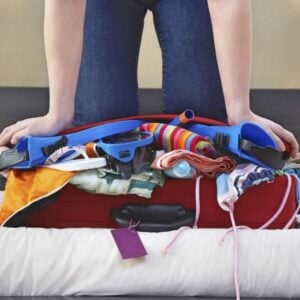The Broke Backpacker is supported by you. Clicking through our links may earn us a small affiliate commission, and that's what allows us to keep producing free content 🙂 Learn more.
Over the years we have experimented with lots of different water filters and purification systems for backpacking and travel. Safe drinking water can be hard to come by in many regions of the world and if you travel or hike enough, you have probably experienced what a dose of polluted water can do to your body.
When our team of adventure junkies discovered Grayl products a few years ago, we felt this big epiphany moment; our water purification needs are sorted forever!
For hikers interested in going ultralight, folks in the bush-craft scene, or even just the average traveler headed to South East Asia, the Grayl Compact Ultralight bottle has proven to be an excellent tool for both staying hydrated on the road and helping to reduce single-use plastic consumption whilst traveling – which is a huge win.
No water purification system is 100% perfect, however. This EPIC review takes a deep dive into the Grayl Compact Ultralight purifier bottle. I’ll cover what I have come to love about the bottle after using it religiously for the past 3 years, and where it comes up short.
Read on to learn whether or not the Grayl Ultralight is the right purifier bottle for your needs and adventures.
Grayl Ultralight Water Purifier Review: Key Features and Performance Breakdown
Grayl Ultralight Key Facts
- Weight: 10.9 oz (309 g)
- Capacity: 16 oz (473 ml)
- Active Technology: ion exchange, ultra-powdered activated carbon
- Flow Rate: 15 seconds per 16 oz (2 liters/minute)
- Removes: waterborne pathogens (99.99% of viruses, 99.9999% of bacteria, 99.9% of protozoan cysts), including Rotavirus, Hepatitis A, Norovirus, Giardiasis, Cryptosporidium, E. Coli, Cholera, Salmonella, Dysentery and more.
- BPA-Free materials: made from polypropylene #5, food-grade silicone, TPE, ABS food-grade plastic
Grayl makes two water purifier bottles: the Grayl Geopress and the Grayl Compact Ultralight bottle. There are some differences between the two including size and capacity.
That said, the main concept is pretty much the same; the bottles’ purifier water using a French-press style system that pushes dirty water up through a filter and into the clean water inner bottle.
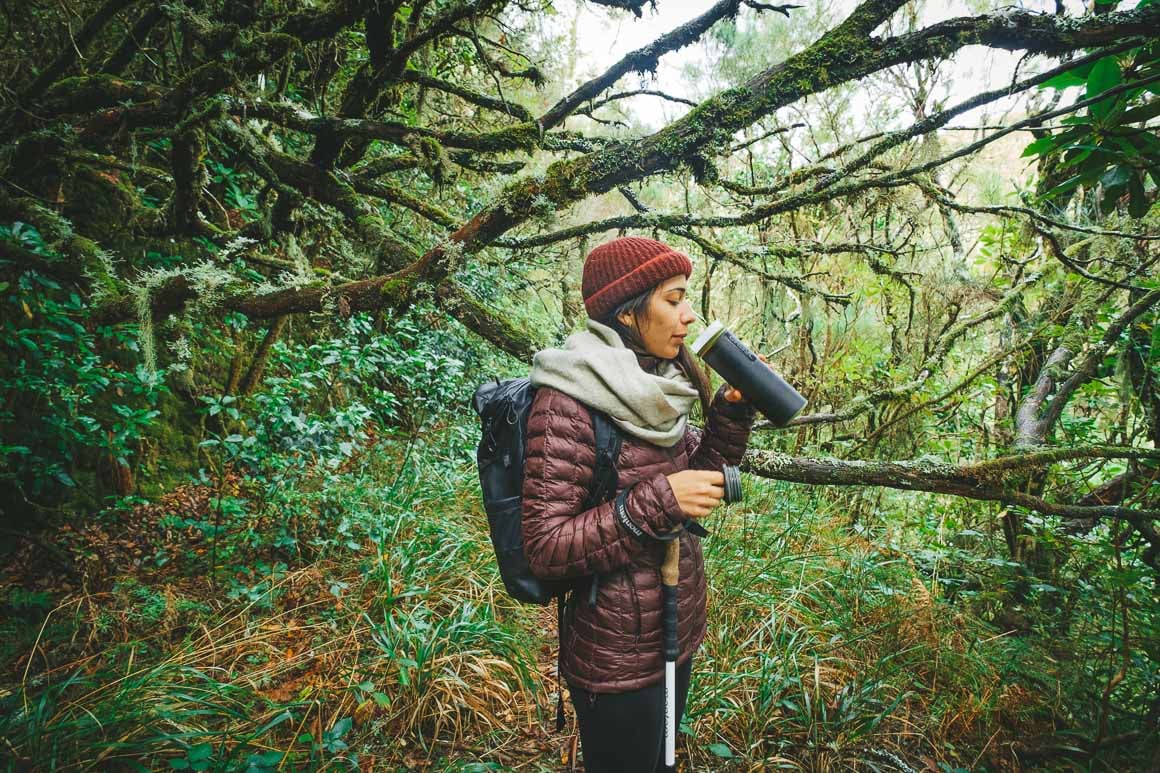
The Broke Backpacker is supported by you. Clicking through our links may earn us a small affiliate commission, and that's what allows us to keep producing free content 🙂 Learn more.
Throughout this article, you will hear me reference the Grayl Geopress from time to time, but for the sake of clarity, this is a Grayl Ultralight review so I will be focusing more on that system.
Check out my in-depth Grayl Geopress review if you want to go down another exciting water purifying rabbit hole.

REI is one of America’s biggest and most-loved outdoor gear retailers.
Now, for just $30, get a lifetime membership that entitles you to 10% OFF on most items, access to their trade-in scheme and discount rentals.
Join REI Today!Water Filtration vs Water Purification
One of the main features of the Grayl Ultralight bottle is the fact that it purifies the water, which is very different from just filtering the water. That’s what makes this Grayl Ultralight water purifier really stand out.
So what the hell is the difference between purifying and filtering you ask?
GOOD QUESTION. This important distinction is lost on most people. They see a Lifestraw and think “right, I can suck water out of the mud in Africa and no misfortune shall penetrate my bowels”.
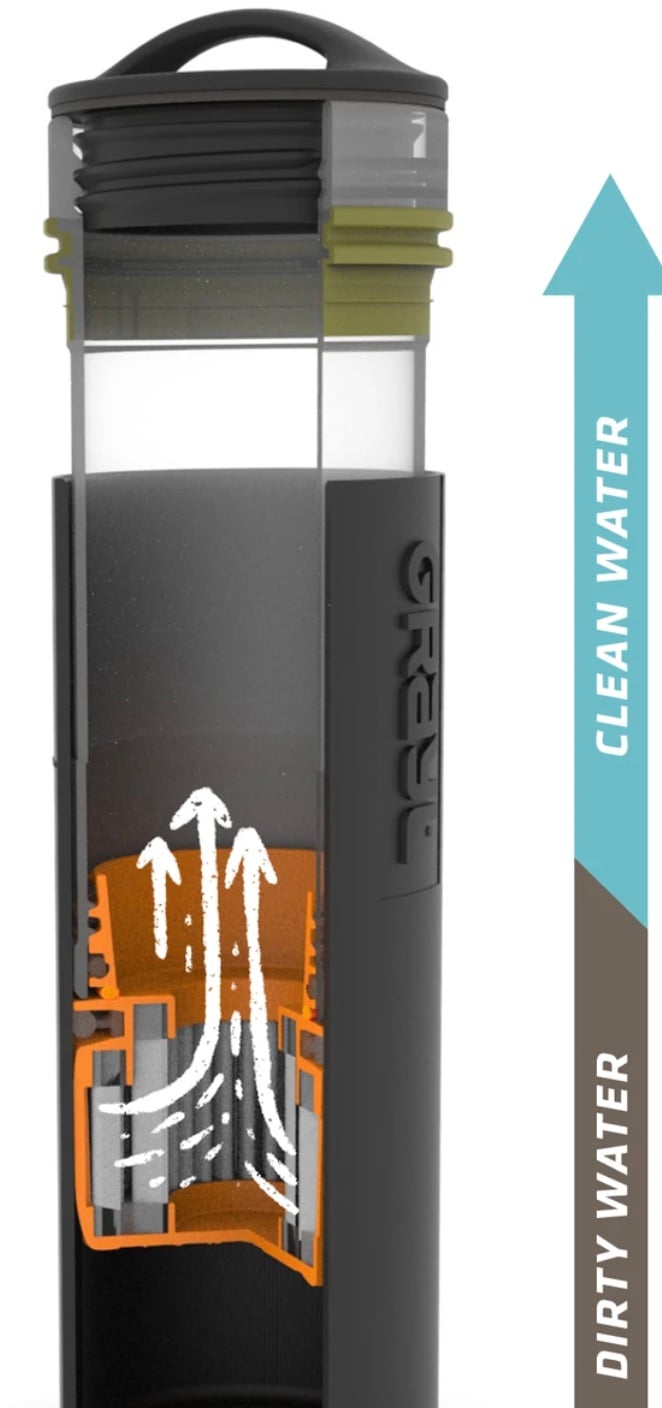
I’ll give it to Lifestraw that their marketing has been successful for them as many people think the filter will save them from all vicious bacteria, viruses, etc – however – that is not entirely accurate.
Micro-plastics. Everyone’s favorite topic. Many filters reduce and/or remove this horrific man-made substance because of size exclusion. It is safe to assume that Lifestraw gets micro-plastics because they use hollow fiber.
While water filters like Lifestraw can eliminate many forms of bacteria and protozoa, they do not remove viruses and the likes of pesticides, chemicals, heavy metals, etc. (it may just reduce them).
Most of their products do not remove pesticides, taste, odor, chemicals, etc., because they do not include a charcoal stage. That being said, many of their “bottles” do have carbon.
This is what makes the Grayl Ultralight bottle so interesting; it purifies the water in question.
But Does the Ultralight Purifier Bottle Really Work?
My experience using the Grayl Ultralight for three years is this: I have purified water from sketchy hotel sinks in Pakistan, taken cloudy glacial water from rivers in Kyrgyzstan, and filled up from public fountains in Havana, Cuba (got to love that commie agua) just to name a few scenarios.
I have never once gotten sick from drinking contaminated water after I have run it through a Grayl bottle. I can’t say the same for back when I used a Lifestraw. The Ultralight water purifying bottle really does seem to do the job and do it well.
So if you are looking for a reliable water purifier water that delivers consistent results; that is what you get with the Grayl Ultralight bottle. I estimate that I have done well over 1000+ presses over the years and the results speak for themselves: I have never had any issues.
How the Grayl Compact Ultralight Works
There are many words I could use to describe what the Grayl Ultralight user experience feels like, but I’ll keep it easy: practical, simple, efficient.
The Grayl Ultralight bottle has no moving parts, pieces to break, or any debris blow-back actions to perform. What you see is what you get.
You start the process by filling up the outside sleeve with the water you want to purify.
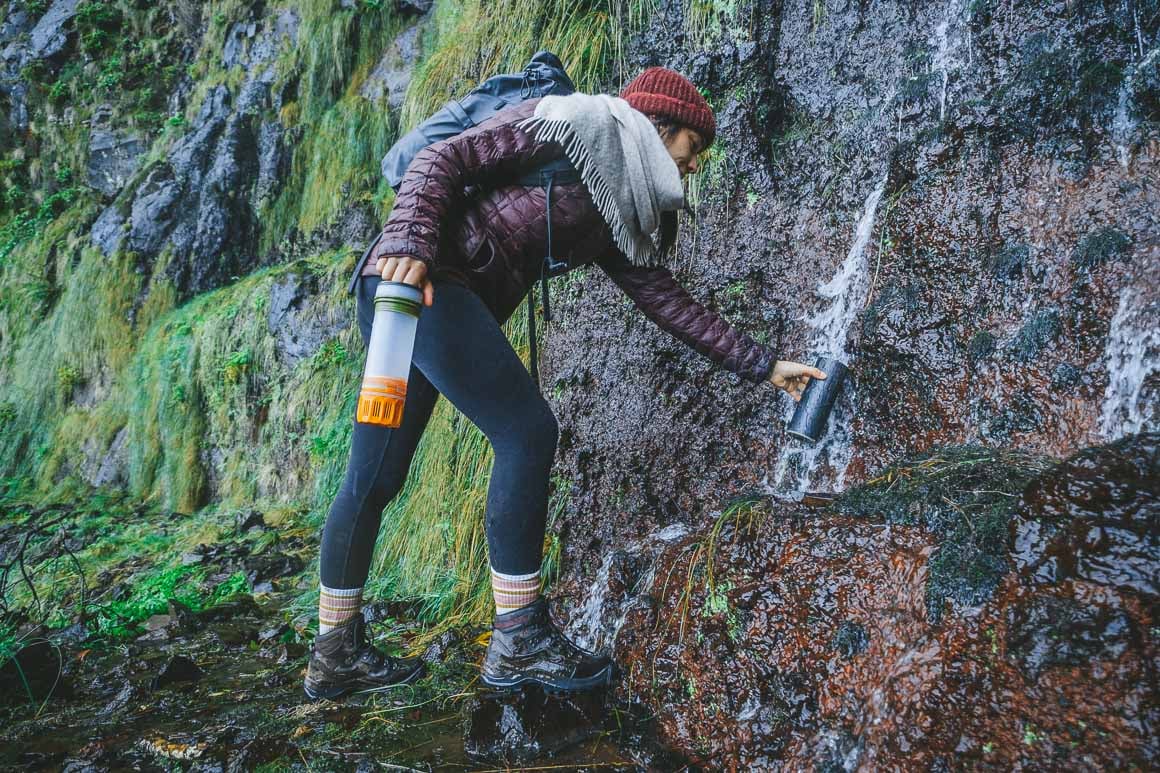
Photo: Chris Lininger
As mentioned, Grayl purifiers employ a press-style technology that pushes dirty water from the outer plastic sleeve, up through the filter into the clean-water inner sleeve. Using the force of your body weight, you simply need to fill the outer reservoir, place the filter connected to the clean-water bottle inner unit at the top of the dirty outer and press down.
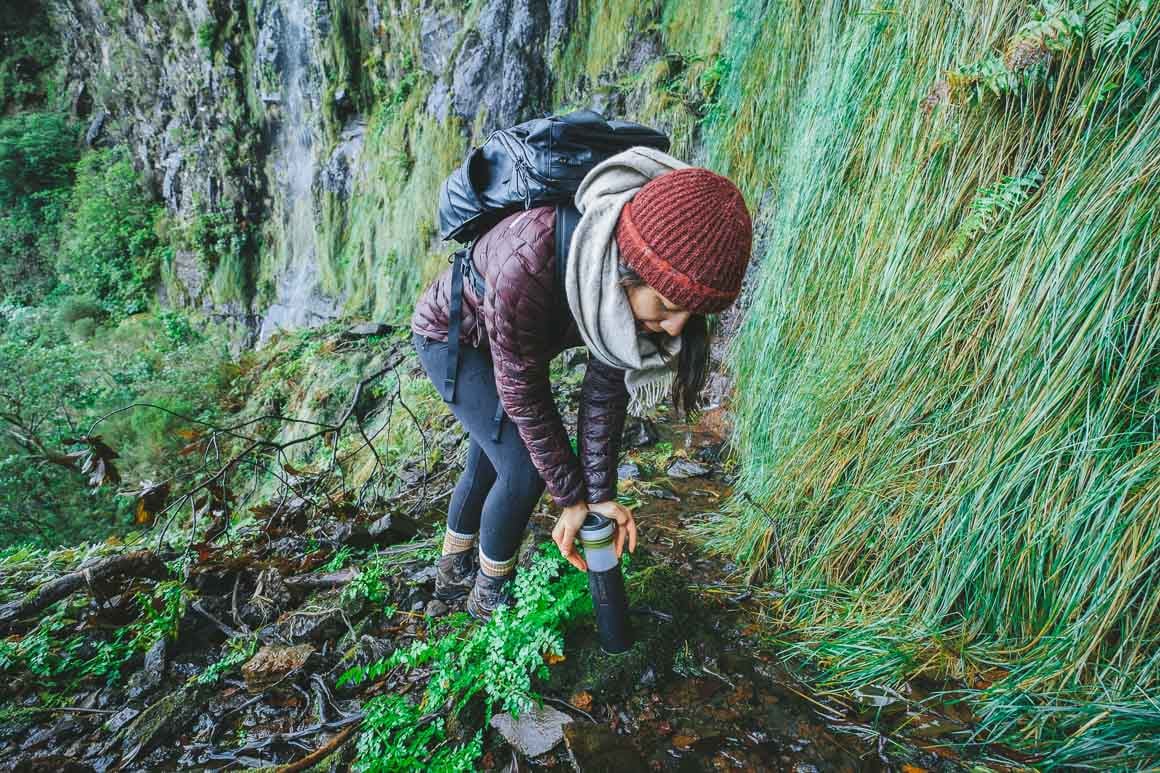
Photo: Chris Lininger
Within 15 seconds of pressing more or less, you have safe drinking water. Boom.
Over time, the flow rate will be longer as the filter builds up sediment or other little microscopic bits. I advise using clear water when possible as muddy/cloudy water with lots of turbidity will shorten the life of your Grayl filter cartridge.
The Press
With the way the Ultralight bottle’s lid is designed, I find it harder and less comfortable to press the bottle than when using the Grayl Geopress – which has wide textured pads for your palms.
I have also found the smoothness of the press to not last as long with the Ultralight vs the bigger Geopress design – which again might be related to how the palm-to-lid pressing action feels different on the two bottles.
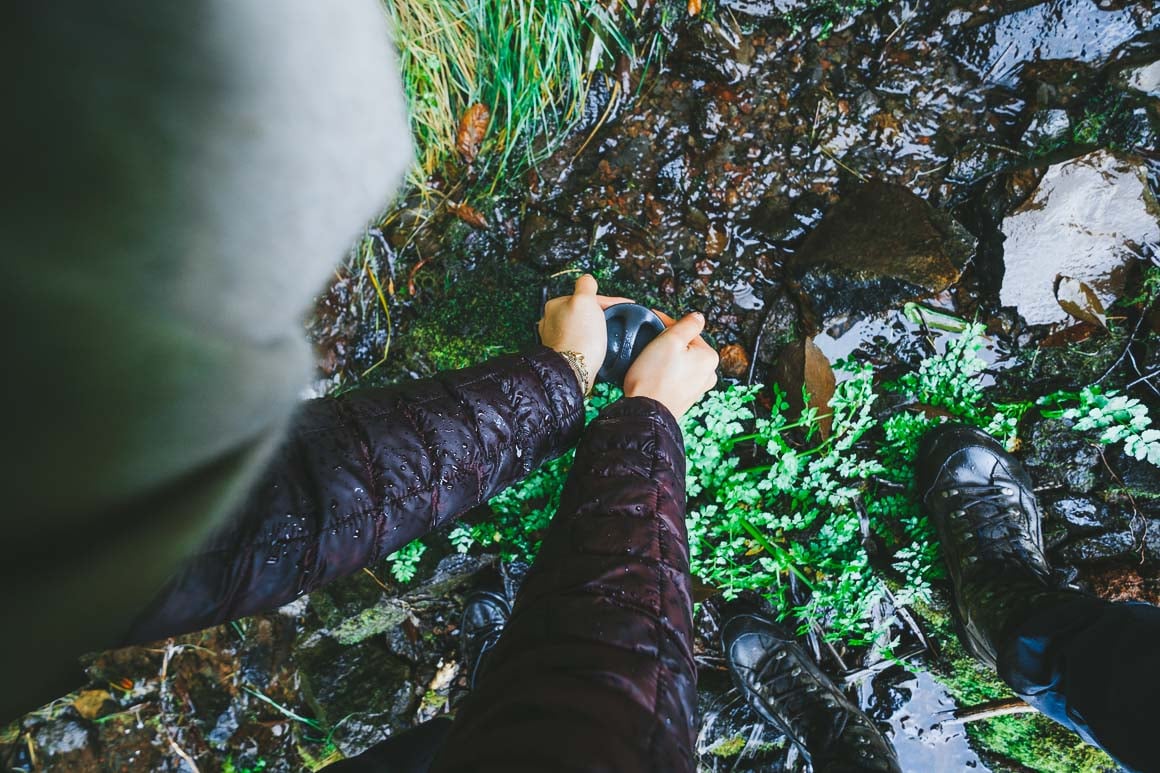
Photo: Chris Lininger
Unscrewing the lid a little bit will aid in the press as it allows some of the air inside the bottle to escape; thus reducing that pressure
When it comes to other filters and purifiers, I find this pressing motion of the Ultralight and Geopress to be much enjoyable than the act of squeezing water through a small filter or sucking up water through a filtered-straw – and I have tried them all nearly at this point.
Whether I am traveling solo or leading a group on a big hike, I like to move and move quickly. If it takes me two minutes and a lot of effort to filter a liter of water – well I am likely to either 1. drink less and dehydrate myself or 2. become frustrated and bitterly curse the filter under my breath (which has been my experience with the Sawyer Squeeze Mini as an example).
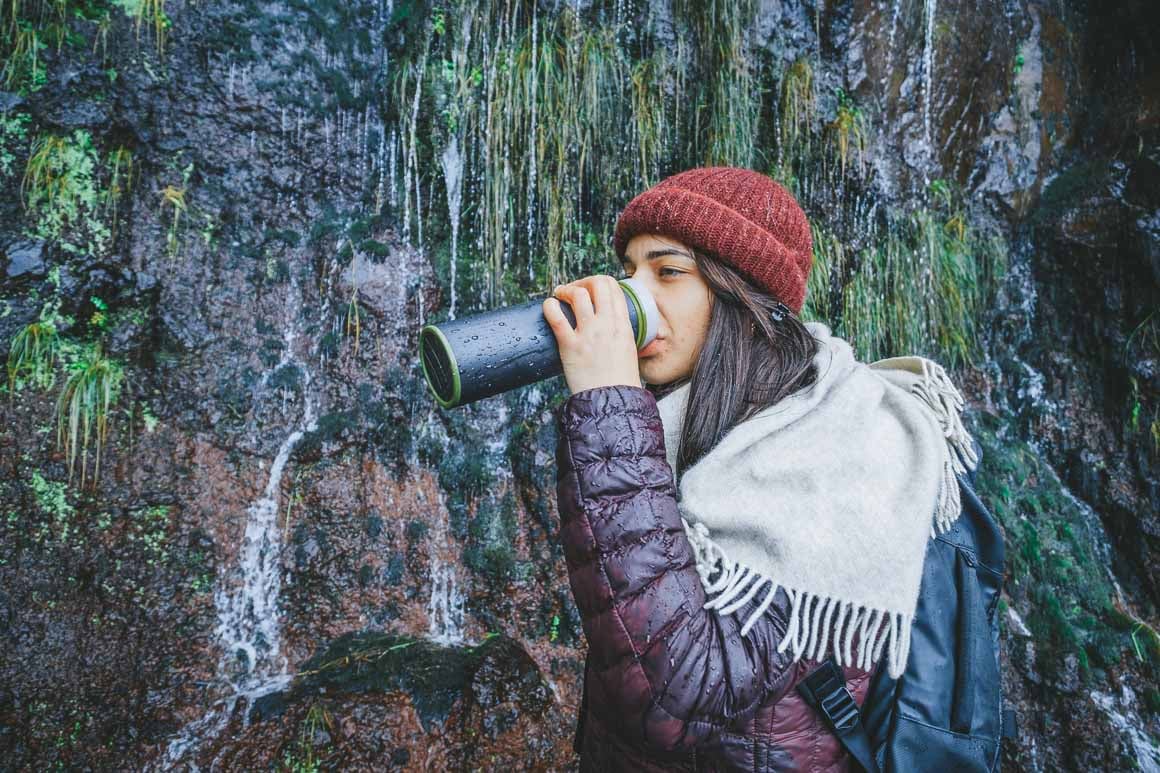
Photo: Chris Lininger
The Technology
So how do the Grayl Ultralight’s purifier cartridges keep your body safe from microscopic Kamikaze organisms?
Grayl cartridges use an ion-exchange and activated carbon system. The ion-exchange permanently binds pathogens (similar to the current state of Donald Trump’s Twitter feed) and prevents them from breaking out of their new home in the cartridge. The active carbon works like a figurative sponge of the cartridge, absorbing heavy metals, weird flavors, and funky smells.
The final element of the purification system is the electro absorptive media – which for all non-chemists and scientists reading this article, pretty much means the said media uses magnetic force to vacuum up pathogens and inorganic compounds.
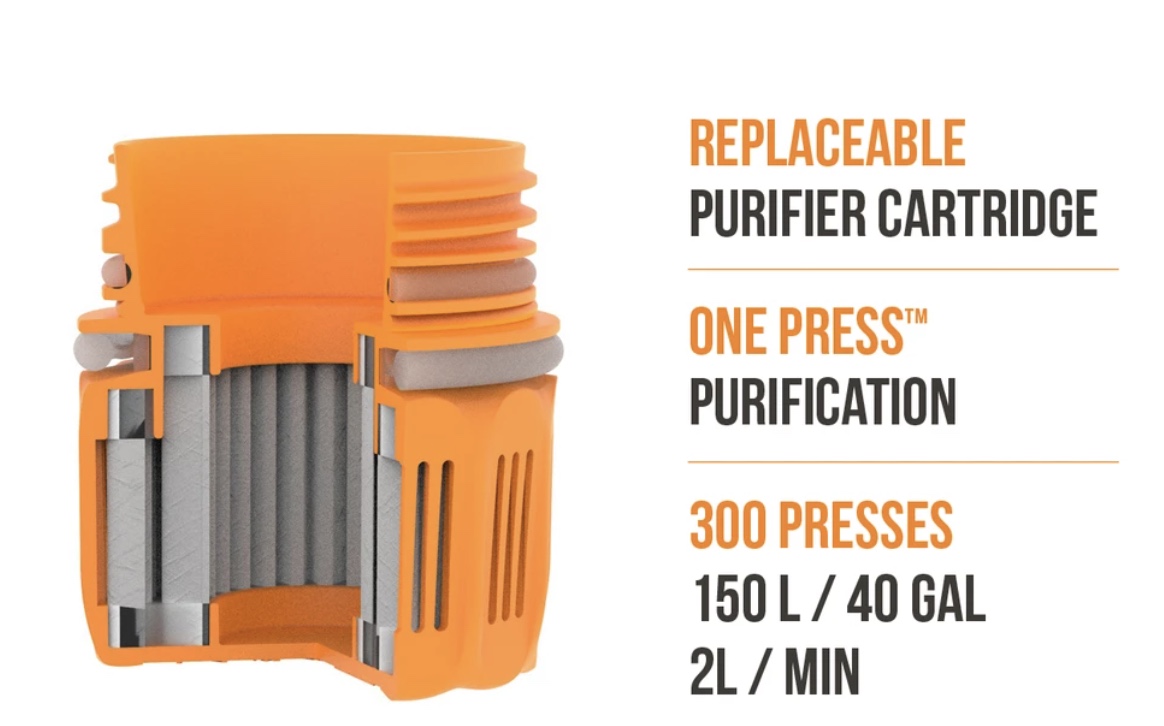
I want to note that I have not personally purified straight up stank-stagnant water as I have always been able to find more appetizing water sources, so I can’t report on exactly how much smell and taste is reduced from water that is in a very bad state.
The Ultralight bottle cartridge is rated for 300 cycles (40 gal. / 150L), though I admit I have gone far beyond that number on a few occasions without issues (though it is not recommended).
Size of The Ultralight Bottle: How Much H2O You Packing Bruh?
The capacity of the Grayl Ultralight bottle is 16 oz (473 ml). This means the bottle can hold the equivalent of a USA beer pint.
For me, the capacity limitations of the Ultralight bottle make it so that I find I use my Grayl Geopress (24 oz.) far more often, especially on big hikes.
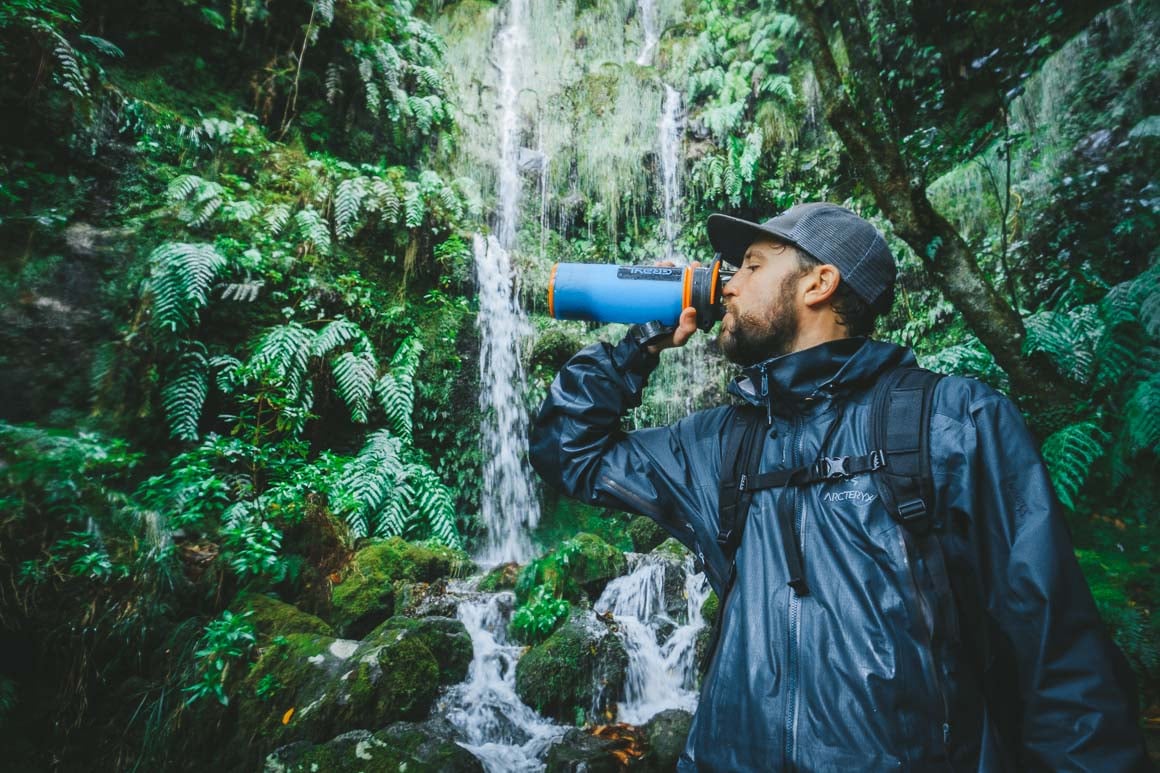
Photo: Chris Lininger
But everyone has different priorities and I would rather carry more weight than have to purify more often. If going fast and light is your priority, then the obvious choice for you should be going with the Ultralight bottle.
The Grayl Geopress may be able to hold more water, but it is also significantly bulkier and does not fit well in small backpack water bottle pockets sometimes.
My girlfriend will tell you she far prefers the compact nature of the Ultralight bottle and she finds the water capacity to be enough for her needs, even on big hikes.
For backpacking and international travel, the Ultralight is good too because it simply takes up less space… and we all probably travel with too much stuff anyway as it is.
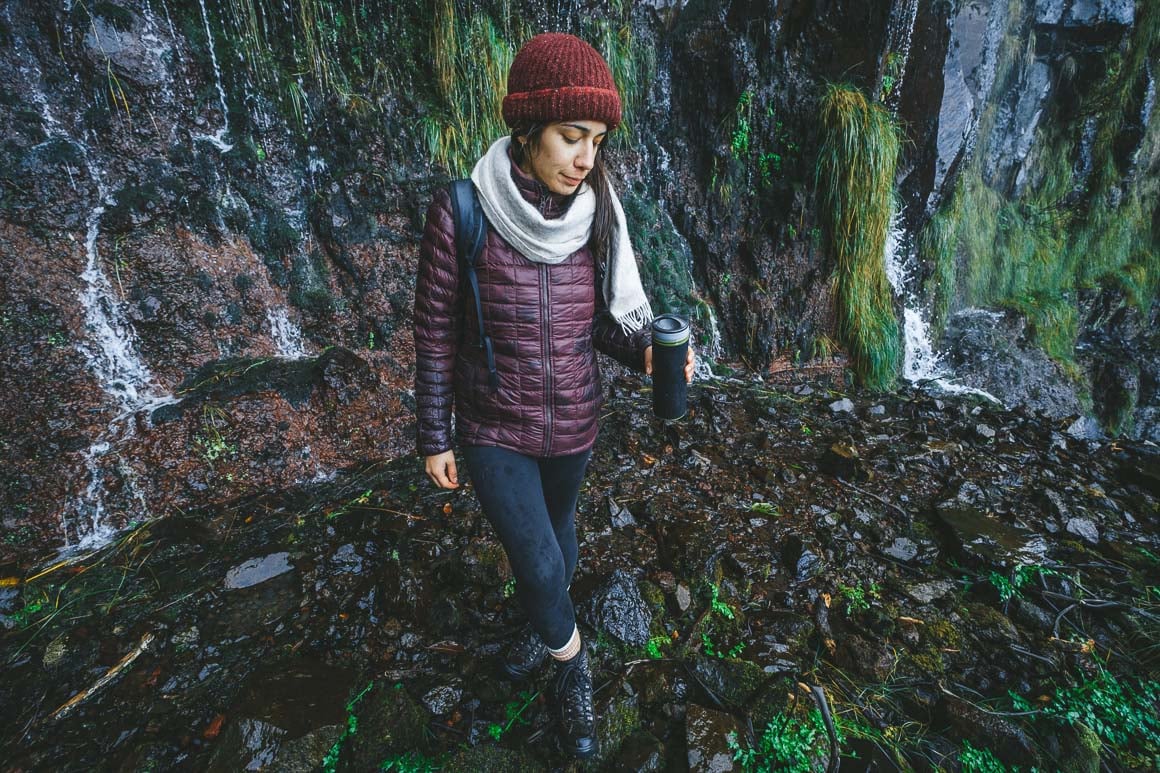
Photo: Chris Lininger
Everyone has their own style, needs, and packing method, so when it comes to choosing a Grayl bottle purely on carrying capacity grounds, that will be a personal choice based on your own needs.
What works best for me (more water is better) might not be good for your system – so before you buy a Grayl bottle one thing to consider is definitely how much water and weight you would like to carry.
Tips for Keeping Your Cartridge Performing at a High Level
Just because having a Grayl Ultralight bottle in hand means you can purify water all across the world without worry should not mean that you fail to take a few basic steps to keep your cartridge performing at a high level.
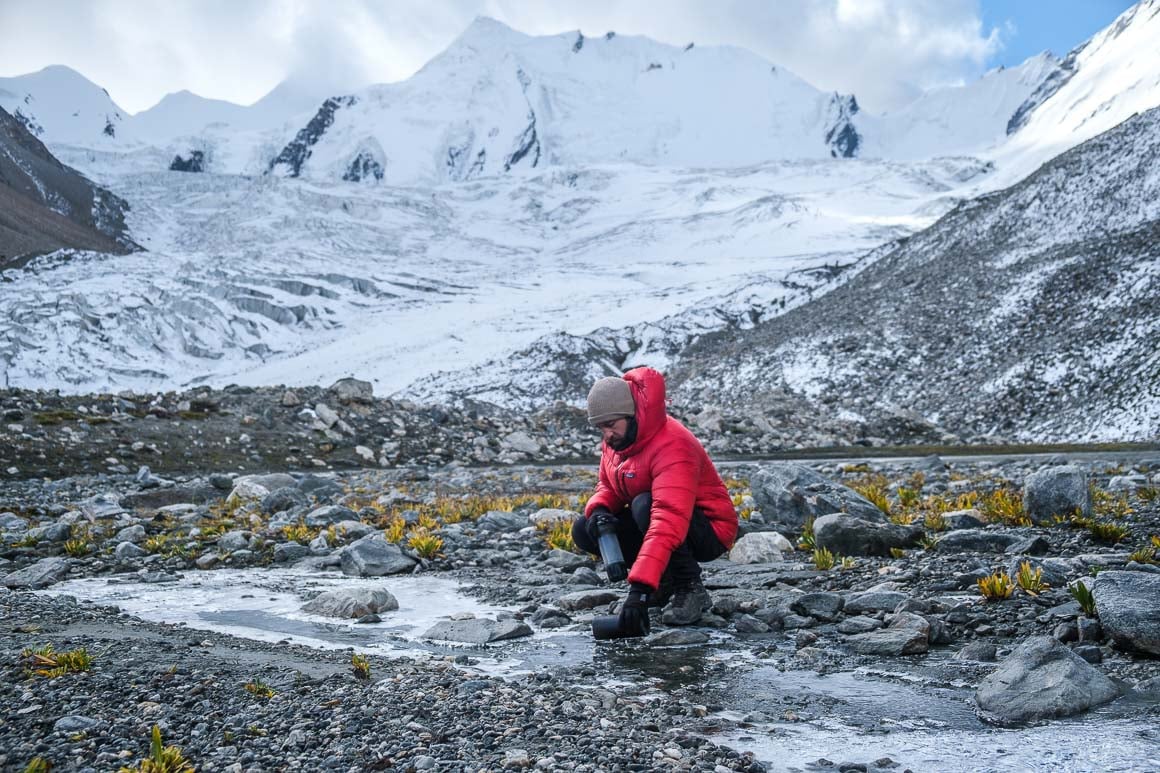
Photo: Chris Lininger
Here are some tips based on my own experiences:
- Keep your bottle and cartridge dry when not in use.
- Avoid filtering muddy or cloudy water if other clear water sources are within reach.
- Keep the clean-inner reservoir full of CLEAN water only. Don’t fill the inside of the bottle without purifying it first (if the source is even a little bit questionable).
- Don’t let your cartridge freeze and thaw repeatedly.
- In winter camping conditions wrap your bottle in a down jacket or an equivalent to provide a bit of insulation.
- Don’t attempt to turn water into wine (by storing anything other than water in your Grayl bottle).
Benefits of Going Ultralight
This issue ties back into the carrying capacity. If carrying 16 oz. is enough for you, then there is a lot to be said for reducing the weight of the water bottle you will carry.
For hikers especially the difference in weight and size between the Ultralight bottle vs the Geopress is enough to be a serious factor for consideration.
When I hiked the Appalachian Trail back in 2015 the Ultralight is the kind of bottle I wish I had. The Geopress would have been great from a practical point of view, but for a hike like that I was counting every ounce I was carrying pretty much. The Ultralight would have been the right unit to take.
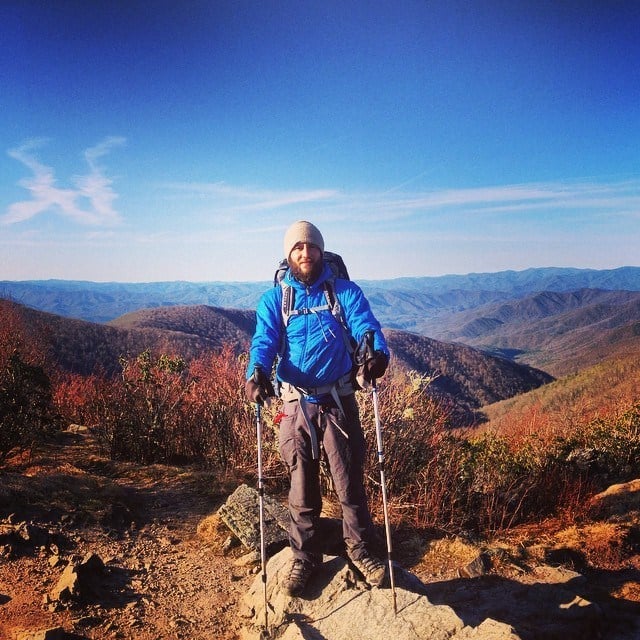
Photo: Chris Lininger
So thru-hikers, multi-day backpackers, and like-minded weirdos who cut down their toothbrushes to little stubs to save base weight, the Grayl Ultralight bottle is probably the unit you should go with for hydration and purifying needs.
For reference, I used the Sawyer Squeeze Mini on my AT thru-hike. It was great on one hand because it weighs nothing – but when it came to using it every day, I found myself thinking that squeezing water using a Sawyer Mini felt like roughly the same flow volume output as a spider’s pee stream. It was SLOOOOW.
I can’t recommend going with the Sawyer Mini for thru-hiking unless you are truly an ultralight nut hell-bent on saving every last gram.

Now, you could spend a fat chunk of $$$ on the WRONG present for someone. Wrong size hiking boots, wrong fit backpack, wrong shape sleeping bag… As any adventurer will tell you, gear is a personal choice.
So give the adventurer in your life the gift of convenience: buy them an REI Co-op gift card! REI is The Broke Backpacker’s retailer of choice for ALL things outdoors, and an REI gift card is the perfect present you can buy from them. And then you won’t have to keep the receipt. 😉
Buy on REI!Best Uses of the Grayl Compact Ultralight Purifier
There are endless scenarios and activities when having a water purifying tool is useful.
Speaking from my own experiences using the Ultralight purifier bottle over the last few years, I can say in all honesty that adding this purifier bottle to my kit has completely changed how I travel, how I plan adventures, and how I think about my relationship with water in general.
Anyone who has traveled outside of “The West” will tell you that each day of a trip in Thailand as an example involves buying at least 2 liters of water in a (more often than not) single-use plastic bottle.
This is frankly unacceptable. Countries like Thailand have HUGE plastic waste management problems and unless you have been living under a rock, you should be very aware that single-use plastic is literally destroying our oceans and all of the creatures that inhabit them.
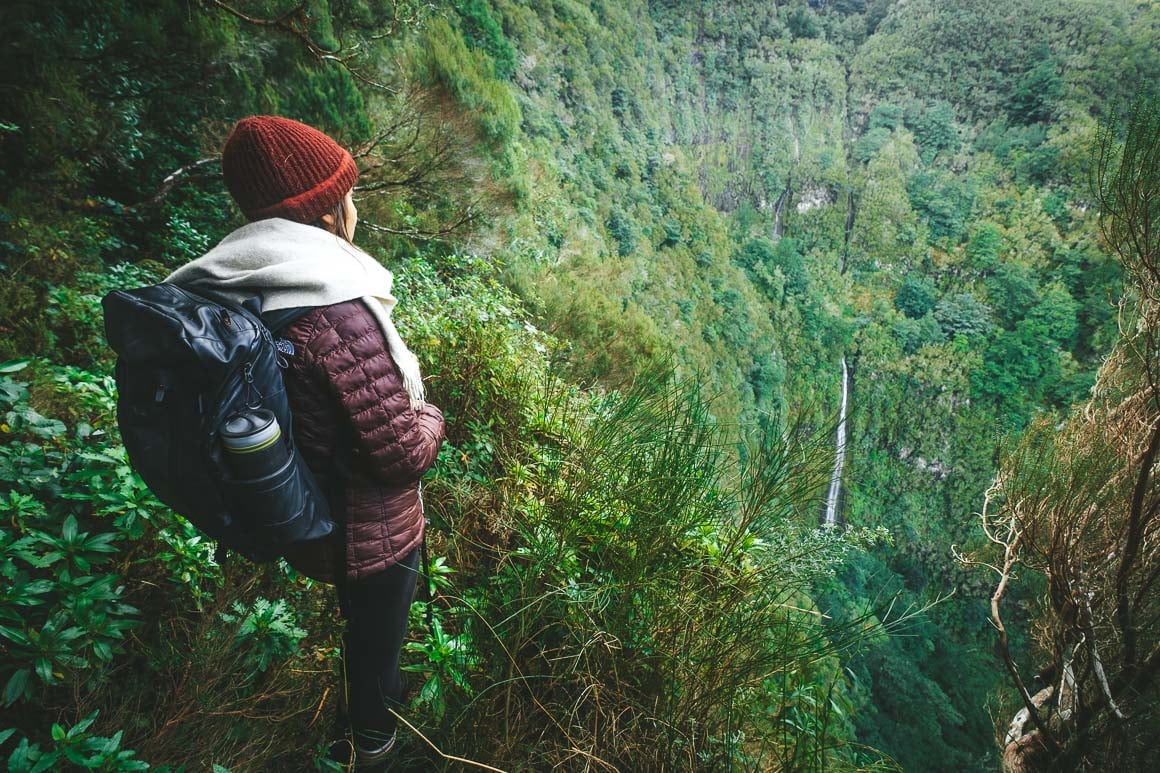
Photo: Chris Lininger
The point being, I am not here to judge you or the way you choose to travel. You do you. I am just here to emphasize that you have the tools here – be it a Grayl Ultralight or a Grayl Geopress – to essentially remove single-use plastic water bottles from all of your international (and domestic) travel and hikes.
There really is not an excuse anymore to buy water unless you are traveling through a scorched part of the Sahara Desert where there literally is no water to be found – and if that is the case good luck trying to find someone to sell you water anyway, ha!
How much does the Grayl Ultralight Bottle Cost?
The price of the Ultralight bottle is $69.95. You may be thinking, woah that is a lot for a water bottle – and you’re not wrong. But as part of our Grayl review, we’ve got to cover why exactly it’s worth it!
Know what else is expensive? 1. a hospital bill for contracting Giardia duodenalis and 2. Buying 2-3 water bottles every day on a multi-month backpacking holiday. That shit adds up. Do the math and it does not take long for you to spend $70 on bottled water if you are traveling for a couple of months.
Good gear just requires an investment. Period. If there is one piece of kit that you should splash out on this year, it is a Grayl water bottle.
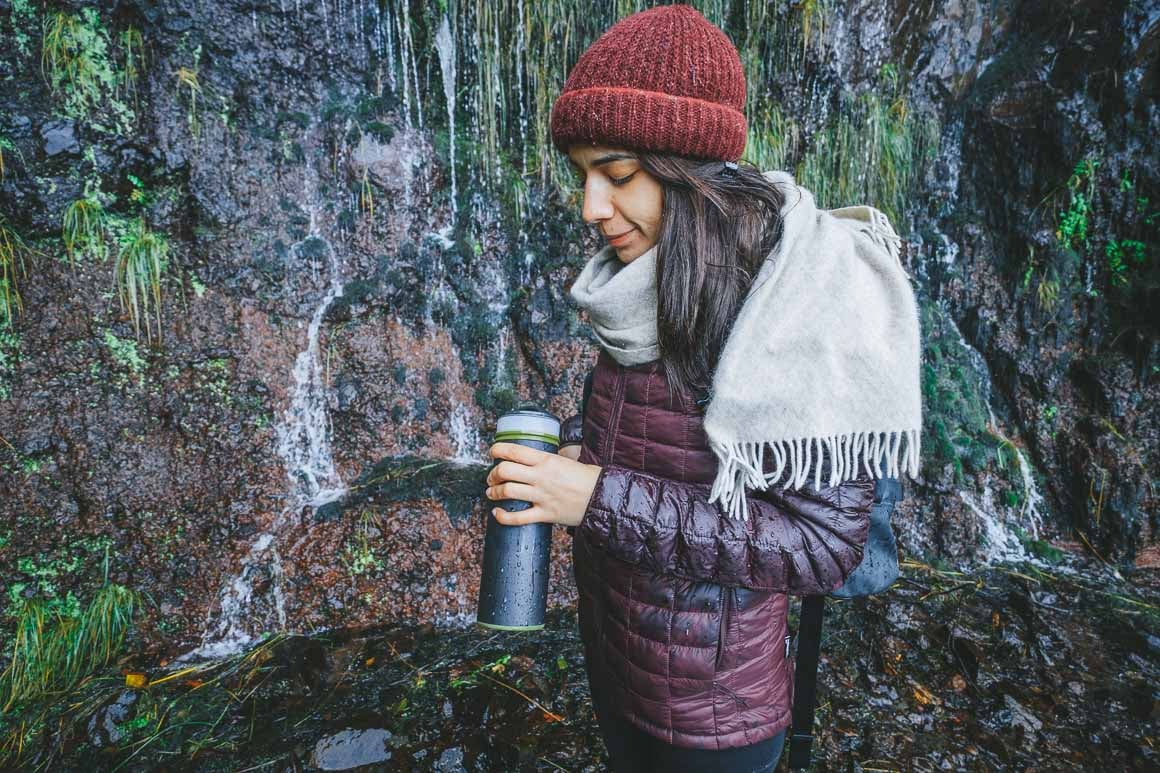
Photo: Chris Lininger
Another cost factor to consider is the replacement cartridge. Depending on how often you use your Grayl bottle, eventually, you will need to buy a replacement cartridge. These run $24.95.
When you initially buy your Grayl Ultralight I recommend picking up some extra cartridges too so that you have them on hand. If you are planning a long trip, I suggest packing an extra cartridge at the bottom of your backpack.
On the rare occasion that I did not have access to my stash of cartridges, I probably pushed the limits of an old cartridge too far. This isn’t necessarily the safest choice since after too many uses, the cartridge is not as effective in stopping microscopic Armageddon – or at least so I have been told.
What I don’t Like about The Grayl Ultralight Water Purifier
It wouldn’t be a fair Grayl Ultralight purifier bottle review if we didn’t mention what we didn’t like too.
As mentioned, no piece of gear is 100% perfect and though the overall performance has left me singing songs of praise from mountain tops, here is what I don’t like about the Grayl Ultralight purifier bottle:
- Water Storage Capacity: The whole point of this bottle is to carry less weight and go light. Criticizing an ultralight bottle for being small and ultralight seems counterintuitive. For me personally, I like having more water on hand so 16 oz. doesn’t feel like enough for some of the kinds of serious adventures I do.
- Difficulty Pressing Over Time: One of the drawbacks of using the Ultralight bottle with an old cartridge is that at some point, it becomes rather difficult to press down. If the press action is taking you longer than 25 seconds and requires a Herculean effort to press, it’s probably time to change the damn cartridge. The Ultralight water bottle filter system does have a lifespan and unfortunately, it does seem to come around pretty quickly!
- Only Comes in Plastic: I can dream that maybe Grayl has some special design in the works for the future, but for now, the Grayl Ultralight compact purifier bottle only comes in plastic. Not that big of an issue for me, but I do know hikers who are metal/steel-vessel drinkers only.
- Can’t Filter Coffee Grounds: Please don’t even try. The folks at Grayl know where I stand on this issue. Give the people a Grayl Coffee Press!

Our GREATEST Travel Secrets…
Pop your email here & get the original Broke Backpacker Bible for FREE.
Final Thoughts on the Grayl Ultralight Water Purifier Bottle
So, with great sadness, we’ve come to the end of our Grayl Ultralight water purifier review.
In the pursuit of my current lifestyle and ambitious outdoor objectives, I come in contact with gear. Lots of gear. Some items I find convenient to “just have around” and others I consider 100% essential to what I do. The Grayl Ultralight falls into the latter category.
If I had to choose five items to pack for a weekend (or a month) out in a wild environment, I would back a Grayl bottle every single time – it’s that simple.
It’s one of those things that once you know, you know – and there will be no going back to an alternative on-the-fly water purification system.

Photo: Chris Lininger
Whether you are hitting the road in search of backpacker glory for the first time, or are a seasoned bush-craft expert, having a Grayl Ultralight bottle in your kit will pay dividends beyond measure and keep you safe and hydrated along the way.
We hope you’ve found our Grayl water bottle review helpful. Let us know below.
So if you are asking “is the Grayl Ultralight worth the money?” The answer is simple; you’re godd*** right. I’m giving this one a 5 out of 5!
Our Rating of the Grayl Ultralight?

Thanks for taking the time to read this Grayl Ultralight review. If you have any experience using this water purifier bottle, let us know in the comments below! Stay hydrated amigos.
Buy Us a Coffee!
A couple of you lovely readers suggested we set up a tip jar for direct support as an alternative to booking through our links, since we’ve decided to keep the site ad-free. So here it is!
You can now buy The Broke Backpacker a coffee. If you like and use our content to plan your trips, it’s a much appreciated way to show appreciation 🙂






